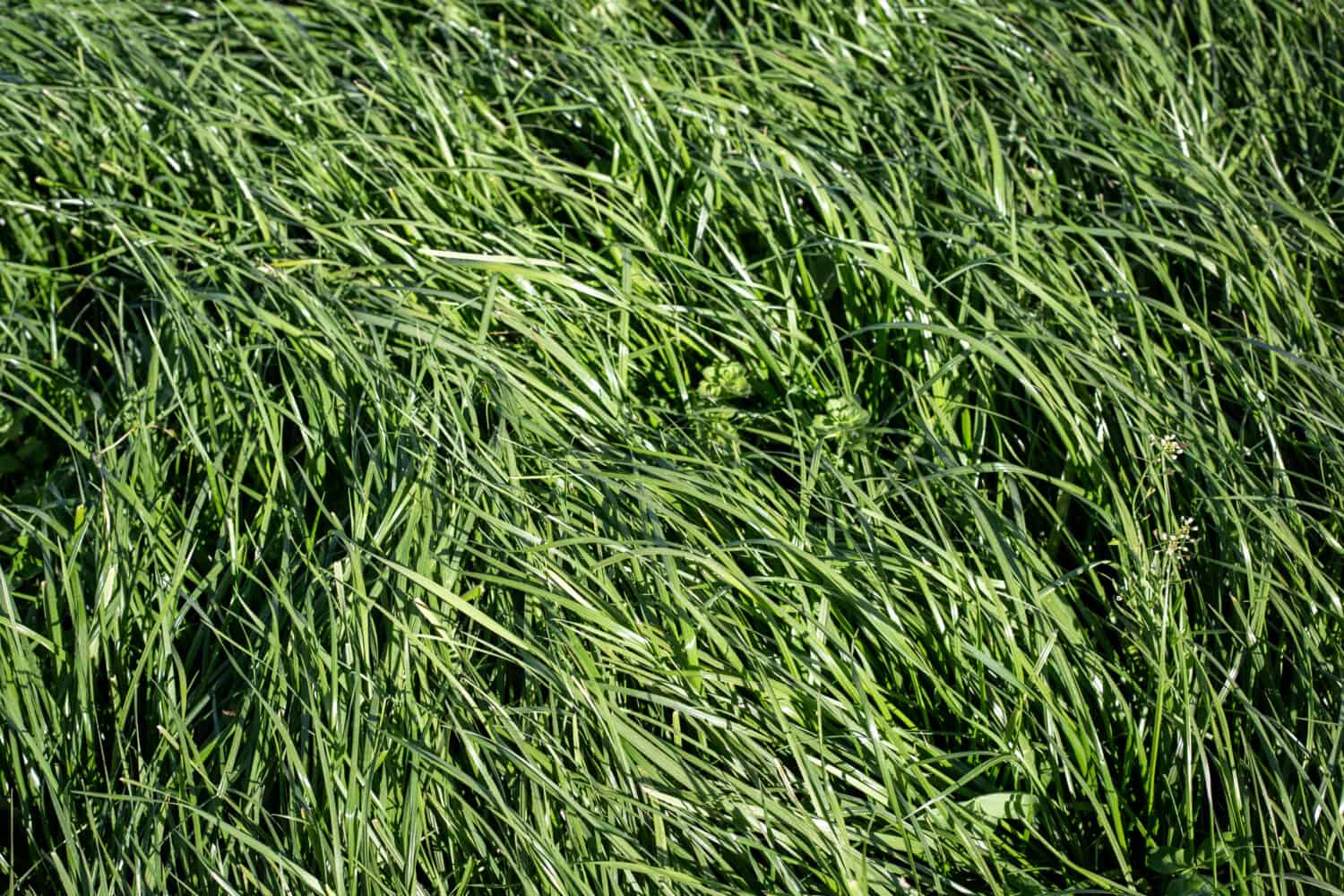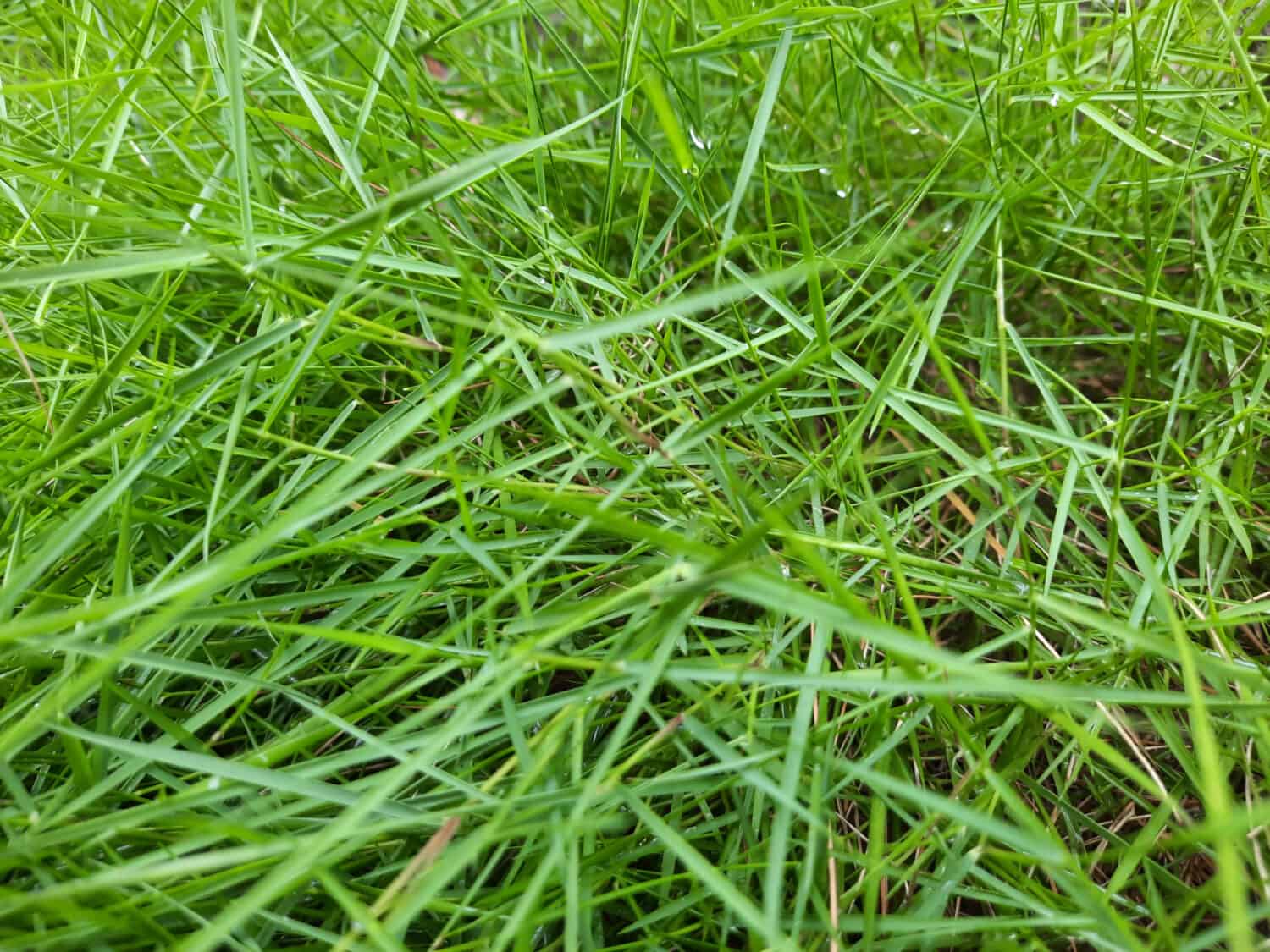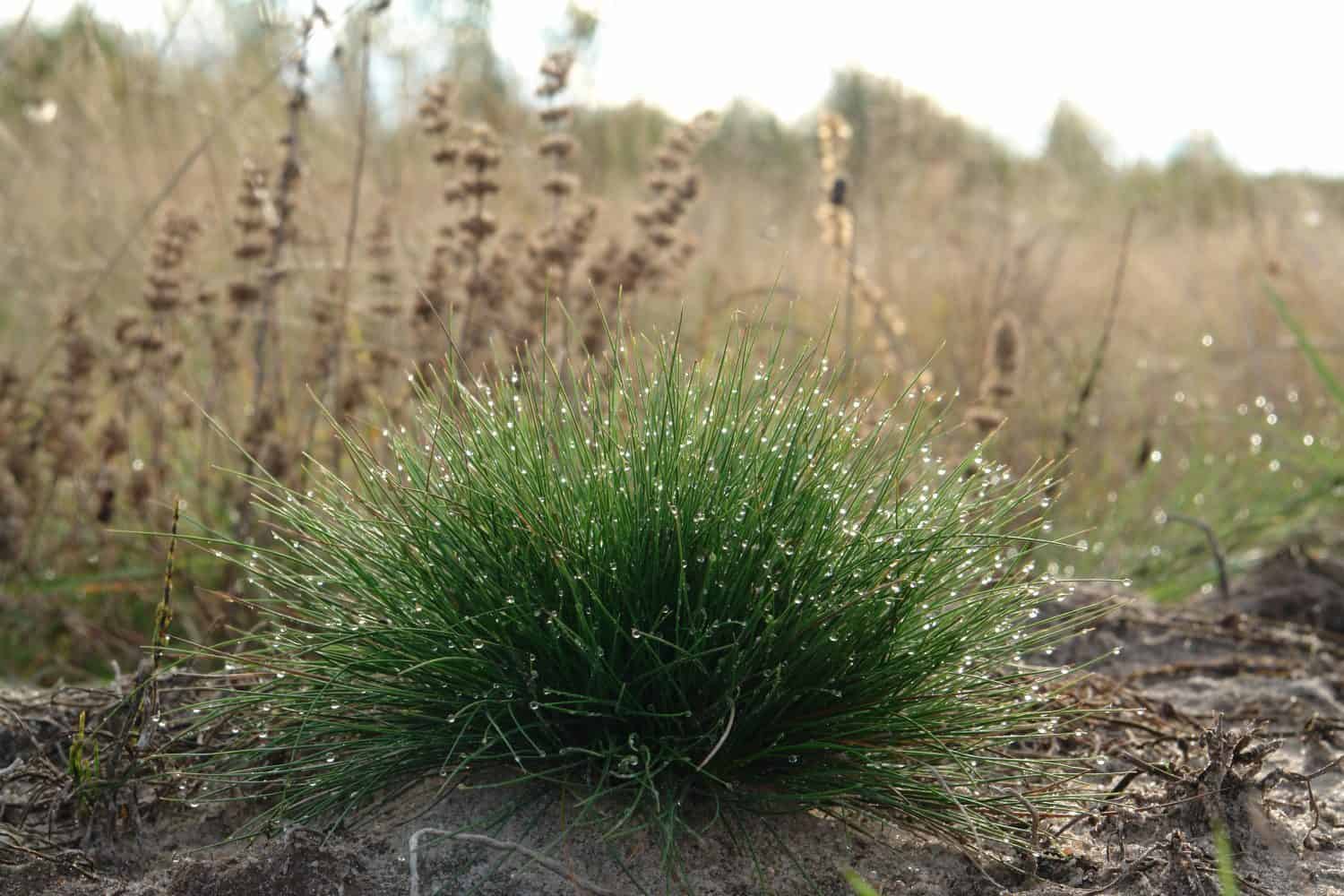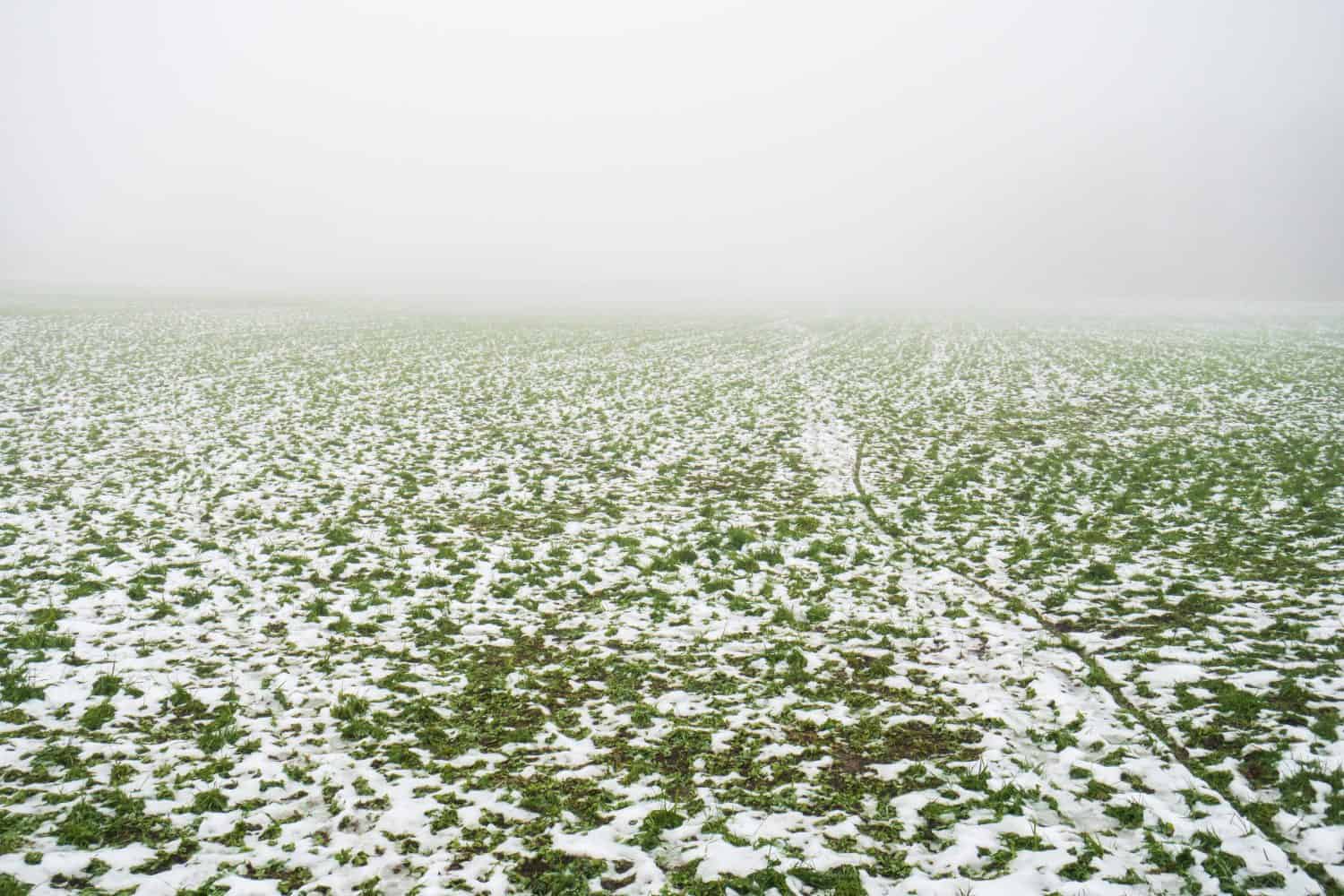The sheer ubiquity of grass makes it a front-runner in any garden. Perfect for creating luscious lawns and aesthetic backdrops for a flower garden, the humble grass is incredibly versatile. It renders warm, tranquil landscapes that other plants can seldom match!
But grass, like most other plants, is vulnerable to climate change. There are cool-season grass varieties that thrive and flourish in the winter while other grass varieties sulk and take on a tan or brown appearance or become dormant in the cold weather. Here are seven amazing types of grasses that stay green in the winter.
Tall Fescue

Fescue is a popular cool-weather turf grass that has excellent heat, cold, and drought tolerance!
©Sheryl Watson/Shutterstock.com
The tall fescue is a medium to dark green cool-season grass with conspicuously ridged surfaces, smooth undersides, and rough edges. This perennial grass species is prized for its ability to stay green during cool weather while also being able to tolerate warm summer temperatures and even drought conditions.
They grow best in the transition zones (the area between the cool area in the north and the warm area in the south) of the United States and into Canada. The tall fescue requires very little maintenance and has good weed and disease resistance. They can also endure heavy foot traffic and are widely utilized in grazing systems within the Southern and Mid-Atlantic US. As far as cold hardiness is concerned, they are best suited for USDA Plant Hardiness zones 3-8.
Kentucky Bluegrass

This winter-proof grass has a distinct bright green to blue-green color!
©Joshua Boman/Shutterstock.com
The Kentucky bluegrass is a dark green, soft-textured grass with V-shaped blades and canoe-pointed tips. They are a favorite choice for yards, sports fields, and campus landscaping because of their ability to spread and recover quickly from abuse.
This grass species is native to Europe but is found widely throughout the United States as well as in Canada and Mexico. They belong to USDA zones 3-7 which means that it is hardy enough to survive some cold but cannot endure prolonged exposure to icy cold weather. They favor mesic to moist sites and grow best during the fall, winter, and spring months when temperatures are cool. The Kentucky bluegrass is relatively shade-tolerant but generally thrives better in full sun. When stressed by temperatures, poor soils, or a lack of water, they become more susceptible to disease and weed invasion.
Annual Ryegrass

The annual ryegrass is a common weed in cultivated areas and along roadsides.
©PixLove/Shutterstock.com
The annual ryegrass also known as ‘Italian ryegrass’ or ‘winter grass’ is a shiny, coarse, lime-green grass that flourishes in USDA zone 6 (-10℉ to 0℉). This cool-season grass adapts well to sunny conditions and moderate temperatures and is a prime pick in both the northern and southern regions of the United States for winter color.
Annual ryegrass seeds are inexpensive and they germinate and establish quickly. This grass species stays green well into the spring but dies out as soon as the heat of June arrives. They will not tolerate temperature extremes, drought, or shade and have a bit of a reputation for being high maintenance. As a general rule, it is always good to, therefore, discover the best time to plant these grass varieties to give them the best possible chance for survival.
Colonial Bentgrass

The colonial bentgrass is a common perennial grass that is native to Europe.
©Kabar/Shutterstock.com
Colonial bentgrass is a classic cool-season grass that will happily tolerate winter temperatures. This species of grass thrives best in cool, humid weather and grows well in coastal regions in northern California. They can tolerate some shade but have a very low tolerance for heat, water stress, salinity, and traffic.
As a high-maintenance grass species, they also require frequent irrigation, proper mowing, and a relatively high level of fertilizers. In extreme weather, they tend to easily fall prey to diseases and summer insects.
Creeping Bentgrass

The leaves of the creeping bentgrass have a blue-green to dull-gray appearance.
©Funbee/Shutterstock.com
The creeping bentgrass is an extremely fine textured grass with a pointed tip and a tall membraneous ligule. This cool-season turf grass species is a durable favorite that is widely used for golf course fairways, lawn tennis facilities, and lawn bowling greens. It is not, however, a desirable choice in traditional lawns because regular maintenance and upkeep of this grass species requires a lot of skill and expense.
It is well-adapted to cool, humid regions such as the northeast, northwest, and upper Midwestern U.S. (Hardiness zones 3-5) and performs well in full sun. The creeping bentgrass can also tolerate moderate shade and wet soils. However, this high-maintenance turf grass requires frequent watering, mowing aerating, good drainage, and plenty of fertilizer.
Fine Fescue

Of all the fine fescues, the sheep fescue is the most drought and heat-tolerant.
©prambuwesas/Shutterstock.com
Fine fescue is an umbrella term that is used to describe several different types of turf grass species such as chewing fescue, hard fescue, red fescue, sheep fescue, etc. All of these turf grass species are winter-hardy plants that maintain their lush appearance in cold weather.
They have thin, folded blades that are not usually veined and are known to be one of the most shade-tolerant turfgrasses. This cool season grass species also requires very little maintenance and needs minimal mowing, irrigation, and fertilizer. They are less prone to dormancy during severe drought conditions and are most likely to flourish in USDA zones 3-5.
Perennial Ryegrass

Known for its bunchy form, the perennial ryegrass grows from 1 to 2 feet tall.
©S.O.E/Shutterstock.com
The perennial ryegrass is a fine-textured quick-growing grass species with a bunch form. It has a high tolerance for cold temperatures and grows best in coastal regions that have moderate temperatures (zones 5-7) throughout the year.
They are very competitive, germinate quickly, and thrive best on dark rich soils. The perennial ryegrass prefers full sun, although they will tolerate partial shade. They are also particularly hardy and resistant to foot traffic. Their outstanding wear tolerance makes them ideal to use around schools, parks, and homes.
Summary Table of the Types of Grass That Stay Green During Winter
| Grass Type | Plant Maintenance | Shade Tolerance | Cold Tolerance | Plant Hardiness Zone |
|---|---|---|---|---|
| Tall Fescue | Low maintenance | Medium | High | Zones 3-8 |
| Kentucky Bluegrass | Moderate to high maintenance | Low to medium | Medium | Zones 3-7 |
| Annual Ryegrass | Moderate to high maintenance | Low | Medium | Zone 6 |
| Colonial Bentgrass | Moderate to high maintenance | Low to Medium | Medium | Zones 4-9 |
| Creeping Bentgrass | High maintenance | Low to medium | High | Zones 3-5 |
| Fine Fescue | Low maintenance | High | Medium to high | Zones 3-5 |
| Perennial Ryegrass | Low maintenance | Low to medium | Medium | Zones 5-7 |
Thank you for reading! Have some feedback for us? Contact the AZ Animals editorial team.








